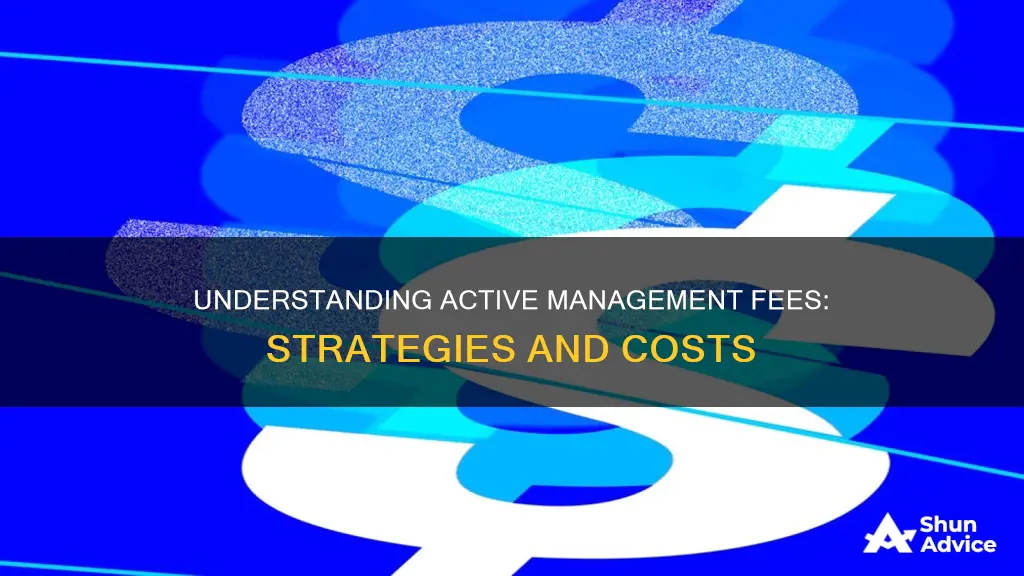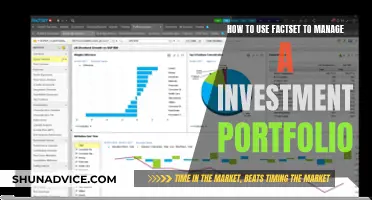
Active management fees are the costs of having an investment fund professionally managed by an investment manager. These fees are intended to compensate managers for their time and expertise in selecting stocks and managing the portfolio. They can also include investor relations expenses and administrative costs. The fees are usually based on a percentage of assets under management (AUM) and can range from 0.10% to over 2%. Actively-managed funds generally have higher fees than passively-managed funds but do not necessarily deliver better returns. Investors considering active management should carefully evaluate the actual returns after fees.
What You'll Learn
- Management fees are typically 0.10% to 2% of assets under management (AUM)
- Actively-managed funds tend to have higher fees than passively-managed funds
- Investment advisors' fees are negotiable and should be transparent
- Sales fees are paid to agents/brokers as commission
- Trading costs are fees for buying/selling securities

Management fees are typically 0.10% to 2% of assets under management (AUM)
The fee structure for actively managed funds can be complex and vary from fund to fund. Some funds may charge a flat annual fee, while others may work on a commission basis, charging a dollar amount per transaction. It's also common for advisers to set up two separate accounts, one fee-based and the other commission-based. Additionally, funds may have different breakpoints, where the fee is reduced as the amount of AUM increases.
When considering an actively managed fund, it's essential to evaluate the fund's performance after fees. While active management aims to outperform the market, studies comparing active and passive management have not conclusively proven which strategy yields better results. Therefore, investors should carefully assess the fund's returns after accounting for management fees to ensure they are getting value for their money.
Furthermore, investors should be aware of additional fees that may be associated with their investments. These can include trading costs, expense ratios, and sales fees. Trading costs are incurred when buying or selling individual positions within the fund, while expense ratios are annual fees deducted from the investor's balance, typically ranging from 0.05% to 2%. Sales fees are commissions charged by agents or brokers who sell financial products, and they can be structured as load fees or ongoing sales fees. Understanding and evaluating all these fees is crucial for investors to make informed decisions and avoid unnecessary costs.
Invest Wisely: Motorsport Manager Tips for Beginners
You may want to see also

Actively-managed funds tend to have higher fees than passively-managed funds
The higher fees associated with actively-managed funds are intended to cover the cost of paying the managers as well as any administrative costs and investor relations expenses. These funds often require consistent re-examination, careful trading, rebalancing, and tax harvesting, which justifies the higher fees. However, it's important to note that higher fees do not always translate to better returns. According to research, actively-managed funds do not necessarily outperform passively-managed funds and may even result in worse returns in some cases.
One reason for the higher fees in actively-managed funds is the level of activity and involvement required from investment managers. Actively-managed funds seek returns that exceed the performance of the overall markets and involve making buy, hold, and sell decisions about the assets in the portfolio. This approach requires sustained efforts from investment advisers, who employ various strategies to identify stocks that are trading at a lower price than their intrinsic value. The fees charged by actively-managed funds compensate these investment advisers for their expertise and the potential for higher returns.
Additionally, actively-managed funds offer benefits in tax management and risk management. The flexibility to buy and sell allows managers to offset losses with gains, providing an advantage in tax management. Moreover, active fund managers can more nimbly manage risks by reducing exposure to certain sectors or using hedging strategies such as short selling and derivatives. These additional services provided by actively-managed funds contribute to the higher fees charged to investors.
In summary, actively-managed funds tend to have higher fees than passively-managed funds due to the increased involvement of investment managers, the potential for higher returns, and the additional benefits offered in tax and risk management. However, it's important for investors to carefully consider the fee structure and evaluate the actual returns after deducting the fees to make informed investment decisions.
Loans: Saving or Investing? Understanding the Financial Impact
You may want to see also

Investment advisors' fees are negotiable and should be transparent
Investment advisor fees are not set in stone and can be negotiated. These fees are typically based on a percentage of the assets under management (AUM) and can range from 1-2% of the total investment. In recent years, due to technological advancements and increased awareness, these fees have been closer to an average of 1%. It is important to remember that if you are being charged more than 1%, you should be receiving personalised financial planning services.
Investment advisors should be transparent about their fees, and this information can be found in their Form ADV Part 2, specifically under "Item 5: Fees and Compensation". This form provides full disclosure of the fee structure, allowing clients to understand the costs associated with their investments.
Additionally, it is worth noting that there are two main layers of fees: external and internal. External fees occur outside the financial product, while internal fees occur inside the financial product as an operating expense. External fees include trading costs, which are custodial fees for completing a buy or sell order of a security trade. These costs vary depending on the company holding the investments, with low-cost custodians often charging less than $10 per trade. Internal fees include trading costs incurred by investment managers when buying and selling individual positions within the fund.
By understanding the fee structure and being aware of the different types of fees, investors can make informed decisions and ensure they are not paying unnecessary or excessive fees. It is always worth asking about fees, as they can significantly impact the overall returns on investments.
SPF Beheer and Investment Management: Related or Separate Entities?
You may want to see also

Sales fees are paid to agents/brokers as commission
Sales fees, also known as commission-based fees, are paid to agents/brokers for selling financial products. These fees can vary depending on the product and the agent/broker. Here are some common types of sales fees:
Load Fees
Load fees are paid to the agent/broker as a commission when the investment is purchased (front-loaded) or sold (back-loaded). These fees typically range from 3% to 8% and are often associated with insurance/annuity products and A-share mutual funds.
On-going Sales Fee
The on-going sales fee is similar to the load fee, but the commission is reduced (usually 1-3%) and paid annually for the duration of the investment. While it may seem lower than front-loaded fees, the on-going sales fee can ultimately be more expensive for longer-term investments. Insurance/annuity products and C-share mutual funds often include this type of fee.
Trading Cost
Trading cost is a custodial fee charged for completing a buy or sell order of a security trade. This fee varies depending on the company holding the investments. Low-cost custodians like TD Ameritrade, Schwab, Fidelity, and E*Trade usually charge less than $10 per trade.
Expense Ratio
This is an annual fee charged by all funds, deducted from the investor's balance. The expense ratio can range from 0.05% to 2% and is typically higher for actively managed funds compared to passively managed funds.
It is important to note that agents/brokers selling commission-based products may not be held to the same fiduciary standard as fee-based advisors. They are instead held to a suitability standard, which may not always be in the best interest of the client. Additionally, commission-based products can create conflicts of interest, as agents/brokers may be incentivized to sell certain products due to higher commissions.
Becoming an Investment Manager: South Africa's Guide
You may want to see also

Trading costs are fees for buying/selling securities
Trading costs are fees incurred when buying or selling securities. They are also known as transaction costs, and they can include broker commissions and spreads. Trading costs are an important consideration for investors as they directly impact the net returns on investments.
When buying or selling securities, such as stocks or shares, investors may incur trading costs in the form of broker commissions. A broker commission is a fee charged by a brokerage firm for executing a trade on behalf of the investor. These commissions can vary depending on the type of security being traded and the brokerage firm being used. For example, many online brokers offer commission-free trading for stocks but may charge a fee for trading mutual funds.
Another component of trading costs is the spread, which is the difference between the price the dealer pays for a security and the price the buyer pays. The spread can vary depending on the liquidity and volatility of the security being traded. Less liquid securities or those with higher volatility may have wider spreads.
It is worth noting that trading costs are distinct from ongoing fees, which are charged periodically over the life of an investment product or service. Ongoing fees are typically associated with investment funds that require ongoing management or maintenance. In contrast, trading costs are incurred each time a specific transaction occurs, such as the buying or selling of a security.
To minimise trading costs, investors can consider strategies such as aggregating trades or adopting a more passive investment strategy. Additionally, it is important for investors to carefully select their brokers, as some brokers may offer lower trading costs or even free trades for certain types of contracts.
Overall, trading costs are an essential factor for investors to consider when buying or selling securities, as they directly impact the net returns on their investments. By understanding and minimising these costs, investors can maximise their potential profits.
Portfolio Investments: Developing Countries' Failure
You may want to see also
Frequently asked questions
A management fee is a charge for overseeing an investment fund. It is intended to compensate managers for their time and expertise in selecting stocks and managing the portfolio. Management fees are usually based on a percentage of assets under management (AUM) and can range from 0.10% to more than 2% of AUM.
There are two main types of fees: external and internal. External fees occur outside the financial product, such as advisor (management) fees and sales fees. Internal fees occur inside the financial product as an operating expense, such as trading costs and expense ratios.
It's important to understand the different types of fees and how they are calculated. A good adviser will be transparent about their management fees and mutual fund expense ratios. You can also use tools like Morningstar.com to look up a fund's expense ratio and compare it with other funds.
Yes, passive management is a strategy that aims to equal the returns of an index. It involves buying assets that mirror a particular market index and is often considered a more cost-efficient approach. However, there is no consensus on which strategy yields better results: active or passive management.







